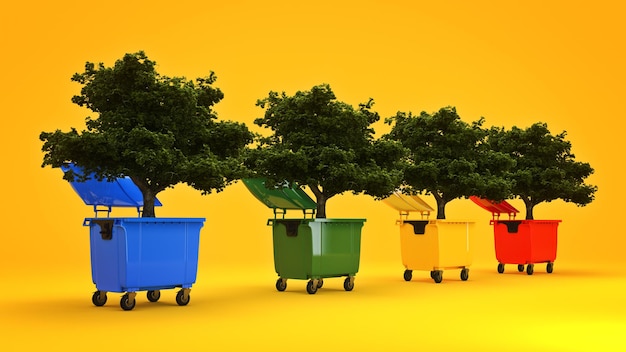Reduce, Reuse, Recycle: Your 2025 Waste Reduction Guide

Reduce, Reuse, Recycle isn’t just a catchy phrase; it’s a vital strategy for sustainable living. This comprehensive guide outlines innovative waste reduction methods for 2025, empowering you to minimize environmental impact through practical, everyday actions.
The principles of reduce, reuse, recycle have been around for decades, but their importance is growing as we face increasing environmental challenges. This guide will delve into practical and innovative strategies for waste reduction in 2025, helping you minimize your impact and contribute to a more sustainable future. Let’s explore how these time-tested concepts can be applied in modern ways.
Understanding the 3 Rs: Reduce, Reuse, Recycle
The mantra of “Reduce, Reuse, Recycle” forms the cornerstone of sustainable waste management. Each element plays a critical role in minimizing our environmental footprint. Understanding the nuances of each R empowers us to make informed choices and adopt practices that truly make a difference.
The Power of Reduction
Reduction is the most impactful of the three Rs. It focuses on minimizing waste at its source, preventing materials from entering the waste stream in the first place. This involves conscious decisions about consumption and purchasing habits.
Here are some strategies for effective reduction:
- Mindful Purchasing: Before buying anything, ask yourself if you really need it. Avoid impulse purchases and opt for products with minimal packaging.
- Digital Alternatives: Choose digital versions of books, magazines, and newspapers to reduce paper consumption.
- Repair and Maintain: Extend the life of your belongings by repairing them instead of replacing them.
The Art of Reusing
Reusing extends the lifespan of products, reducing the demand for new resources and minimizing waste. It involves finding new purposes for items that would otherwise be discarded. This requires a shift in mindset and a bit of creativity.
Consider these ideas for effective reuse:
- Reusable Containers: Use reusable water bottles, coffee cups, and shopping bags.
- Repurpose Jars and Bottles: Clean and reuse glass jars for food storage or crafting projects.
- Donate or Sell: Give unwanted clothes, furniture, and electronics a new home through donation or resale.
The Importance of Recycling
Recycling transforms waste materials into new products, conserving resources and reducing pollution. It’s a crucial step in the waste management process, but it’s important to recycle correctly to ensure its effectiveness.
Make recycling a priority by:
- Understanding Local Guidelines: Familiarize yourself with your local recycling program’s rules and accepted materials.
- Proper Sorting: Separate recyclables from trash and rinse containers to remove food residue.
- Supporting Recycled Products: Choose products made from recycled materials to create demand and close the recycling loop.
By understanding and implementing the principles of reduce, reuse, and recycle, we can significantly decrease waste and protect our environment. Each action, no matter how small, contributes to a more sustainable future.

Innovative Waste Reduction Strategies for 2025
As we approach 2025, innovative strategies are emerging to enhance waste reduction efforts. These methods leverage technology, community engagement, and policy changes to create a more sustainable and circular economy. Embracing these new approaches is essential for achieving significant progress.
Technology-Driven Solutions
Technology plays a crucial role in optimizing waste management. From smart bins to advanced sorting systems, these innovations streamline the process and improve efficiency.
Explore these technological advancements:
- Smart Bins: These bins use sensors to monitor fill levels and optimize collection routes, reducing fuel consumption and emissions.
- AI-Powered Sorting: Artificial intelligence can identify and sort different types of recyclables with greater accuracy than traditional methods.
- Waste-to-Energy Conversion: Advanced technologies convert waste into clean energy, reducing landfill waste and generating renewable power.
Community Engagement Initiatives
Community involvement is vital for successful waste reduction. Engaging residents through education, incentives, and collaborative projects fosters a sense of responsibility and encourages participation.
Consider these community-based approaches:
- Educational Programs: Workshops, seminars, and online resources can educate residents about waste reduction and recycling best practices.
- Incentive Programs: Rewards and recognition for households and businesses that demonstrate exceptional waste reduction efforts.
- Community Gardens: Composting programs and community gardens reduce food waste and promote local food production.
Policy and Regulatory Changes
Government policies and regulations are essential for driving systemic change in waste management. These measures create a framework for sustainable practices and incentivize businesses and individuals to reduce waste.
Advocate for these policy changes:
- Extended Producer Responsibility (EPR): Holding manufacturers accountable for the end-of-life management of their products.
- Single-Use Plastic Bans: Reducing the consumption of disposable plastics through bans and regulations.
- Landfill Taxes: Discouraging landfill disposal by imposing taxes on waste sent to landfills.
By embracing technology, engaging communities, and advocating for policy changes, we can revolutionize waste reduction efforts and create a more sustainable future. These innovative strategies are key to achieving significant progress in 2025 and beyond.
Practical Tips for Reducing Waste at Home
Reducing waste at home is easier than you think. Small changes in your daily routines can have a big impact on the amount of waste you generate. These practical tips will help you create a more sustainable household.
In the Kitchen
The kitchen is often a major source of waste, but with a few adjustments, you can significantly reduce your environmental footprint.
Try these simple steps:
- Meal Planning: Plan your meals in advance to avoid buying more food than you need.
- Proper Food Storage: Use airtight containers to keep food fresh longer and prevent spoilage.
- Composting: Compost food scraps and yard waste to create nutrient-rich soil for your garden.
In the Bathroom
The bathroom can also contribute to waste, but with conscious choices, you can minimize your impact.
Consider these options:
- Reusable Products: Switch to reusable cotton pads, menstrual cups, and cloth diapers.
- Eco-Friendly Toiletries: Choose toiletries with minimal packaging and made from natural ingredients.
- Reduce Water Usage: Take shorter showers and fix leaky faucets to conserve water.
Around the House
From cleaning supplies to household goods, there are many opportunities to reduce waste throughout your home.
Implement these strategies:
- DIY Cleaning Products: Make your own cleaning solutions using simple ingredients like vinegar, baking soda, and essential oils.
- Buy in Bulk: Purchase household staples in bulk to reduce packaging waste.
- Declutter Regularly: Donate or sell unwanted items instead of throwing them away.
By implementing these practical tips, you can transform your home into a hub of sustainable living. Every small effort contributes to a larger movement towards a waste-free future.

Reducing Waste in the Workplace
Extending waste reduction efforts to the workplace is crucial for creating a sustainable and responsible environment. Businesses can implement various strategies to minimize waste, promote recycling, and encourage eco-friendly practices among employees.
Promoting Sustainable Practices
Encouraging sustainable practices in the workplace can significantly reduce waste and promote a culture of environmental responsibility.
- Digital Documents: Encourage employees to use digital documents and reduce paper consumption.
- Reusable Office Supplies: Provide reusable pens, notebooks, and other office supplies.
- Energy Conservation: Implement energy-saving measures such as turning off lights and computers when not in use.
Implementing Recycling Programs
A comprehensive recycling program is essential for diverting waste from landfills and conserving resources.
- Recycling Bins: Place recycling bins in central locations and clearly label them for different materials.
- Education and Training: Provide employees with training on proper recycling procedures.
- Partnerships with Recycling Companies: Work with recycling companies to ensure efficient and effective waste management.
Reducing Food Waste
Food waste is a significant issue in many workplaces, especially in cafeterias and break rooms. Implementing measures to reduce food waste can have a positive impact.
- Smart Ordering: Order food and beverages based on actual demand to avoid overstocking.
- Composting: Compost food scraps from cafeterias and break rooms to create nutrient-rich soil for landscaping.
- Donation Programs: Donate surplus food to local charities and food banks.
By promoting sustainable practices, implementing recycling programs, and reducing food waste, businesses can create a more environmentally responsible workplace. These efforts contribute to a larger movement towards a sustainable future.
The Role of Government and Policy in Waste Reduction
Government policies and regulations play a vital role in driving systemic change in waste management. These measures create a framework for sustainable practices and incentivize businesses and individuals to reduce waste.
Legislation and Regulations
Effective legislation and regulations are essential for setting standards and enforcing compliance in waste reduction.
- Extended Producer Responsibility (EPR): Holding manufacturers accountable for the end-of-life management of their products.
- Landfill Bans: Banning certain types of waste from landfills to encourage recycling and diversion.
- Waste Reduction Targets: Setting specific targets for waste reduction and monitoring progress over time.
Incentives and Subsidies
Incentives and subsidies can encourage businesses and individuals to adopt sustainable waste management practices.
- Tax Credits: Providing tax credits for companies that invest in waste reduction technologies.
- Grants and Funding: Offering grants and funding for community-based waste reduction initiatives.
- Subsidies for Recycled Products: Subsidizing the production and purchase of products made from recycled materials.
Public Awareness Campaigns
Public awareness campaigns are crucial for educating residents about the importance of waste reduction and promoting behavior change.
- Educational Programs: Conducting educational programs in schools and communities to raise awareness about waste reduction.
- Media Campaigns: Launching media campaigns to promote sustainable practices and highlight the benefits of waste reduction.
- Community Events: Organizing community events such as recycling drives and composting workshops to engage residents.
By implementing effective legislation, providing incentives, and raising public awareness, governments can play a pivotal role in driving waste reduction and creating a more sustainable future.
Looking Ahead: The Future of Waste Reduction in 2025 and Beyond
The future of waste reduction is promising, with ongoing innovations and a growing commitment to sustainability. As we approach 2025 and beyond, it’s essential to stay informed and proactive in adopting new strategies and technologies.
Emerging Technologies
Emerging technologies are poised to revolutionize waste management and pave the way for a more circular economy.
- Advanced Recycling Technologies: Developing technologies that can recycle a wider range of materials, including plastics and composite materials.
- Bioplastics: Promoting the use of bioplastics made from renewable resources as an alternative to traditional plastics.
- Smart Waste Management Systems: Implementing smart systems that use data analytics to optimize waste collection and processing.
The Circular Economy
The circular economy is a model that aims to eliminate waste and pollution by keeping products and materials in use for as long as possible.
- Product Design: Designing products for durability, repairability, and recyclability.
- Sharing Economy: Promoting sharing platforms and services that allow people to share and reuse products.
- Closed-Loop Systems: Creating closed-loop systems that recycle materials back into the same products.
Individual and Collective Action
Individual and collective action are essential for achieving significant progress in waste reduction.
- Sustainable Consumption: Making conscious choices about the products we buy and how we use them.
- Community Engagement: Participating in community-based waste reduction initiatives.
- Advocacy: Advocating for policies and programs that support sustainable waste management.
By embracing emerging technologies, promoting the circular economy, and taking individual and collective action, we can create a future where waste is minimized and resources are conserved. The journey towards a sustainable future requires commitment, innovation, and collaboration.
| Key Point | Brief Description |
|---|---|
| ♻️ Reduce | Minimize waste at the source by buying less and avoiding unnecessary packaging. |
| 🔄 Reuse | Find new uses for items instead of throwing them away. |
| 📦 Recycle | Turn waste materials into new products. |
| 🌱 Compost | Decompose organic waste to enrich soil. |
FAQ: Reduce, Reuse, Recycle
▼
Reducing consumption is the most effective. By buying less and choosing products with minimal packaging, you prevent waste from being created in the first place.
▼
Get creative! Use glass jars for storage, repurpose old clothes into cleaning rags, and refill water bottles. There are endless possibilities for reusing items.
▼
Common recyclables include paper, cardboard, plastic bottles, aluminum cans, and glass containers. Check your local guidelines for specific information on accepted materials.
▼
Composting reduces landfill waste, enriches soil, and reduces the need for chemical fertilizers. It’s a great way to recycle organic materials and improve your garden.
▼
Businesses can reduce waste by implementing recycling programs, reducing paper consumption, and composting food scraps. They can also choose eco-friendly products and packaging.
Conclusion
As we look toward 2025, the principles of reduce, reuse, recycle remain as relevant as ever. By embracing innovative strategies, adopting sustainable practices, and fostering a collective commitment to waste reduction, we can create a healthier, more sustainable future for generations to come.





